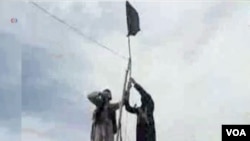Pakistan's Punjab province Counter Terrorism Department (CTD) this week said it killed two prominent Islamic State (IS) operatives in the province and closed "a big chapter" in the history of Islamic State Khorasan (IS-K) in the country.
The CTD statement Thursday said security forces acted based on credible intelligence and raided a house where the suspects were staying. It added the ensuing nighttime shoot-out led to the death of Rizwan and Saqi, members of IS's Khorasan branch.
"CTD Team Multan got a credible source information from a secret agency on four to five terrorists belonging to the Terrorist Organization DAESH (IS-K) including most wanted Red Book POs (Proscribed Persons) Rizwan and Saqi," the statement said, using the Arabic acronym for IS.
The "CTD team raided the place and challenged the terrorists to surrender, but the terrorists started firing at CTD officers," the statement added.
Officials say three other suspected IS members managed to flee the scene into the night, leaving behind a large cache of weapons.
The group, staying in Multan city's Royal Orchard Housing Society neighborhood, was allegedly planning a terror attack against Pakistan's security forces, according to officials.
Officials said a search continues for the other suspects.
The CTD statement traces the IS group to the kidnapping of U.S. citizen and aid worker Warren Weinstein from Lahore in August 2011. A suspected U.S. drone strike against al-Qaida in Pakistan in January 2015 inadvertently led to the death of Weinstein.
According to Pakistani officials, the same IS operatives were involved in the kidnapping and subsequent killing of several Inter-Services Intelligence (ISI) officers in Multan city.
IS in Pakistan
Pakistani military officials in the past have repeatedly denied IS-Khorasan is thriving in the country, alleging the group only imposes a threat from neighboring Afghanistan. They say their raids on the group's members are rare and minimal.
Islamic State Khorasan (IS-K) was founded in 2015 as IS's branch for Central Asia, targeting parts of modern-day Iran, Afghanistan and Pakistan.
Analysts and government officials were initially expressing skepticism about IS-K's existence. Since early 2017, however, the group has been responsible for nearly 100 attacks against civilians in Afghanistan and Pakistan, as well as roughly 250 clashes with U.S., Afghan and Pakistani security forces, according to the Center for Strategic and International Studies.
Amjad Shoaib, a defense analyst and retired army general, told VOA that despite efforts by officials in Islamabad, IS-K officials have been able to conduct isolated attacks, mostly by crossing the border with Afghanistan. He said that most of IS-K members belonged to Tehrik-i-Taliban Pakistan (TTP), a U.S.-designated terror group.
"The IS has been unable to find recruits who are willing to pledge allegiance to [IS leader] Abu Bakir (al-)Baghdadi," Shoaib said.
According Shoaib, "Unlike the TTP, IS has no organized cell, no commander, and no command and control center within Pakistan."
IS in Baluchistan
In May, IS's Amaq news agency claimed the group has created a new branch called Islamic State Province of Pakistan (ISPP). The group a month earlier claimed a suicide attack against the Shiite Hazara minority that left 21 people dead and more than 50 others injured in Quetta, the capital of Pakistan's restive Balochistan province.
Some observers charge that after IS lost its self-proclaimed caliphate territory in Iraq and Syria, the group is likely seeking to find refuge in less-stable areas such as Balochistan.
According to the Pak Institute for Peace Studies (PIPS), an Islamabad-based research group, IS-K in the region is likely using al-Qaida's strategy by creating "regional affiliates" to help establish itself in Pakistan. It found that militant organizations and separatists could be easy targets for the group.
PIPS concluded, "Banned organizations have contributed to waging the attacks claimed by IS."




